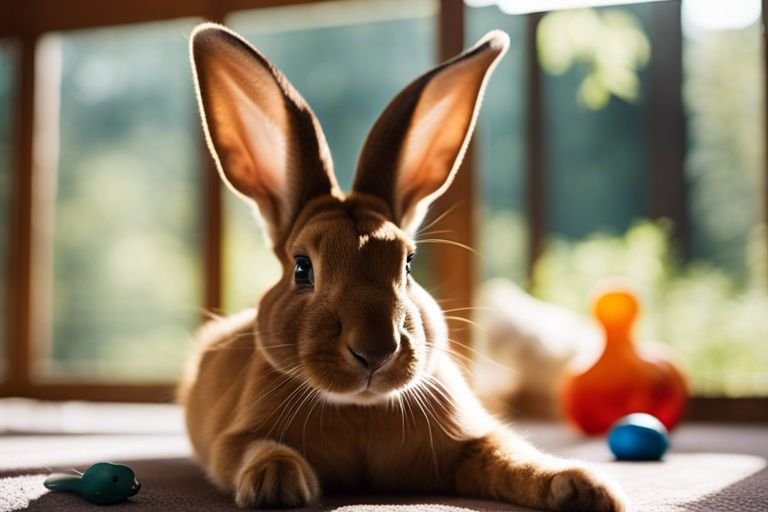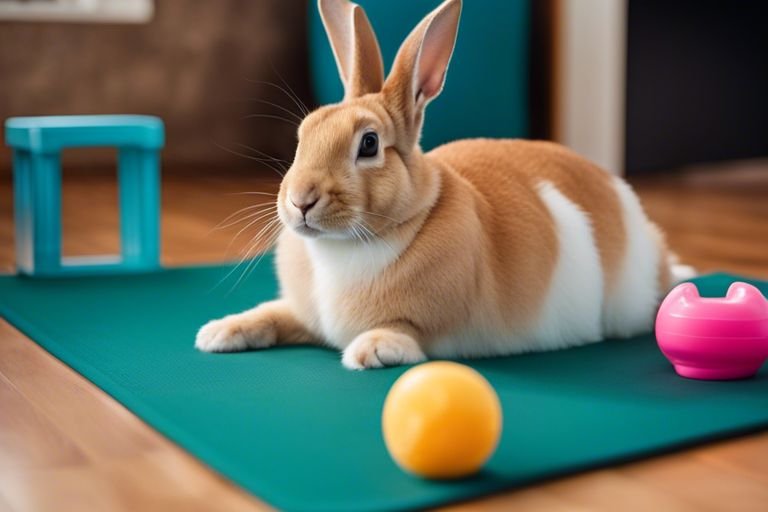Are you a proud owner of a majestic Flemish Giant rabbit? These gentle giants are beloved for their large size and friendly nature, but did you know that they are prone to back muscle strains? These strains can be incredibly painful and debilitating, and it’s important to take proactive measures to prevent them. In this blog post, we will discuss some essential tips and strategies to help you keep your Flemish Giant healthy and prevent back muscle strains. By implementing these measures, you can ensure that your beloved pet stays happy and pain-free for years to come.
Key Takeaways:
- Proper Exercise and Stretching: Implementing regular exercise and stretching routines can help prevent back muscle strains in Flemish Giants by keeping their muscles strong and flexible.
- Provide Ample Space: Ensuring that Flemish Giants have enough space to move around and stretch out can help prevent them from experiencing muscle strains due to cramped living conditions.
- Monitor Weight and Diet: Keeping a close eye on a Flemish Giant’s weight and providing a balanced diet can help prevent excessive strain on their back muscles, preventing potential injuries.
- Regular Veterinary Check-ups: Bringing Flemish Giants to the vet for regular check-ups can help identify any potential health issues that could lead to back muscle strains and address them early on.
- Appropriate Handling and Lifting: Properly handling and lifting a Flemish Giant, especially when moving them or transporting them, can prevent unnecessary strain on their back muscles and reduce the risk of injury.
Anatomy and Physiology
Even though Flemish Giants are adorable and gentle giants, they are prone to back muscle strains due to their large size and weight. Understanding the anatomy and physiology of their back muscles is crucial in preventing these painful injuries.
Structure of Back Muscles in Flemish Giants
The back muscles in Flemish Giants are complex and powerful, consisting of several layers that provide support and stability to their massive bodies. The erector spinae muscles, which run along the spine, play a crucial role in maintaining proper posture and facilitating movement. Additionally, the trapezius muscles, located on either side of the spine and extending to the shoulders and neck, are responsible for shoulder and neck movement. Understanding the intricacies of these muscles can help you identify potential areas of strain and take proactive measures to prevent injuries.
Mechanics of Muscle Strain
When it comes to preventing back muscle strains in Flemish Giants, it is essential to understand the mechanics behind these injuries. A muscle strain occurs when the muscle is stretched beyond its limits or torn due to overexertion. This can happen when you lift your rabbit incorrectly, or when they make sudden, sharp movements. A poorly designed enclosure or inadequate bedding can also contribute to muscle strain by forcing the rabbit to maintain uncomfortable positions. It’s crucial to be mindful of these factors and make necessary adjustments to minimize the risk of muscle strain.
Best Practices for Handling Flemish Giants
Some basic handling techniques can help prevent back muscle strains in Flemish Giants. According to Rabbit Basic Science – PMC, it’s important to handle your Flemish Giant properly to avoid injury and strain. Here are some best practices for handling these large rabbits.
Proper Techniques to Lift and Carry
When handling your Flemish Giant, it’s important to use proper lifting and carrying techniques to reduce the risk of back muscle strains. Always support the rabbit’s hindquarters and chest when lifting them, and avoid lifting them by their front legs. You should also avoid carrying them for extended periods without taking breaks, as this can strain your back muscles.
Reducing Risk During Play and Exercise
During play and exercise, it’s important to supervise your Flemish Giant to ensure they engage in safe activities. Avoid letting them jump from high surfaces or engage in rough play that could lead to injury. Additionally, make sure their exercise area is free of hazards such as sharp objects or small spaces they could get stuck in. Providing a safe environment and monitoring their play can help reduce the risk of back muscle strains.

Housing and Environmental Considerations
Now that you understand the risk factors for back muscle strains in Flemish Giants, it’s important to consider the impact of their housing and environment on their overall back health. The design of their living space and the surfaces they interact with on a daily basis can significantly influence the likelihood of muscle strains.
Designing a Back-Friendly Living Space
When it comes to designing a living space for your Flemish Giant, it’s crucial to prioritize their back health. Ensure that their enclosure is large enough to allow for ample movement and exercise. Additionally, provide plenty of soft, supportive bedding to cushion their joints and muscles. Avoid using platforms or levels that require excessive jumping, as this can put strain on their back muscles. Creating a comfortable and spacious living environment will go a long way in preventing back muscle strains in Flemish Giants.
The Role of Bedding and Surfaces
Your choice of bedding and surfaces in your Flemish Giant’s living space can have a significant impact on their back health. Opt for soft, supportive bedding materials that offer cushioning for their joints and muscles. Avoid surfaces that are too slippery, as this can lead to slips and falls that may strain their back muscles. Additionally, be mindful of any rough or abrasive surfaces that could cause discomfort or injury. By providing appropriate bedding and surfaces, you can proactively protect your Flemish Giant from back muscle strains.
Nutrition and Health Maintenance
Keep your Flemish Giant rabbit in optimal health by paying attention to their nutrition and overall well-being. A balanced diet and regular veterinary check-ups are crucial for preventing back muscle strains and keeping your bunny healthy and strong. Here’s what you need to know about nutrition and health maintenance for your Flemish Giant.
Diet’s Impact on Muscle Health
When it comes to preventing back muscle strains in your Flemish Giant, their diet plays a crucial role. A diet that is rich in high-quality hay, fresh vegetables, and limited pellets will provide the necessary nutrients for strong muscles and overall health. Make sure that your rabbit has access to fresh water at all times and avoid overfeeding, as obesity can put unnecessary strain on the back muscles. Including vitamin C-rich foods, such as bell peppers and leafy greens, in their diet can also promote muscle health and reduce the risk of injury.
Importance of Regular Veterinary Check-ups
Regular veterinary check-ups are critical for maintaining your Flemish Giant’s overall health and well-being. Your veterinarian can assess your rabbit’s muscle strength and flexibility, identify any potential issues, and provide guidance on nutrition and exercise. Additionally, they can administer preventive care, such as vaccinations and parasite control, which are essential for preventing diseases that could affect your rabbit’s muscle health. By scheduling regular check-ups, you can proactively address any concerns and ensure that your rabbit’s muscles remain strong and healthy.
How Can We Prevent Back Muscle Strains In Flemish Giants?
So, it is important to take proactive measures to prevent back muscle strains in your Flemish Giant. This includes providing them with a spacious and well-structured living environment that allows for plenty of movement and exercise. Additionally, it is essential to ensure that your rabbit maintains a healthy weight through a balanced diet and regular exercise, as excess weight can put strain on their back muscles. Regular check-ups with a veterinarian can also help identify and address any potential health issues that could contribute to muscle strains. By taking these steps, you can help keep your Flemish Giant healthy and prevent back muscle strains.
FAQ
Q: What are some tips for preventing back muscle strains in Flemish Giants?
A: To prevent back muscle strains in Flemish Giants, it’s important to ensure that their living space is spacious enough to allow for ample movement. Avoid lifting them by their front legs and always support their hindquarters when handling. Additionally, provide ramps instead of stairs to help minimize the strain on their back muscles.
Q: How can exercise help in preventing back muscle strains in Flemish Giants?
A: Regular, low-impact exercise can aid in preventing back muscle strains in Flemish Giants. Encourage activities like gentle walks or short periods of supervised play to help strengthen their muscles and maintain flexibility. However, it’s important not to overexert them, particularly when they are still growing.
Q: Are there any dietary considerations to prevent back muscle strains in Flemish Giants?
A: Maintaining a healthy weight is crucial in preventing back muscle strains in Flemish Giants. Avoid overfeeding them and ensure they are receiving a well-balanced diet to prevent obesity, which can put added strain on their back muscles. Consult with a veterinarian to determine the appropriate diet for your Flemish Giant’s specific needs.
